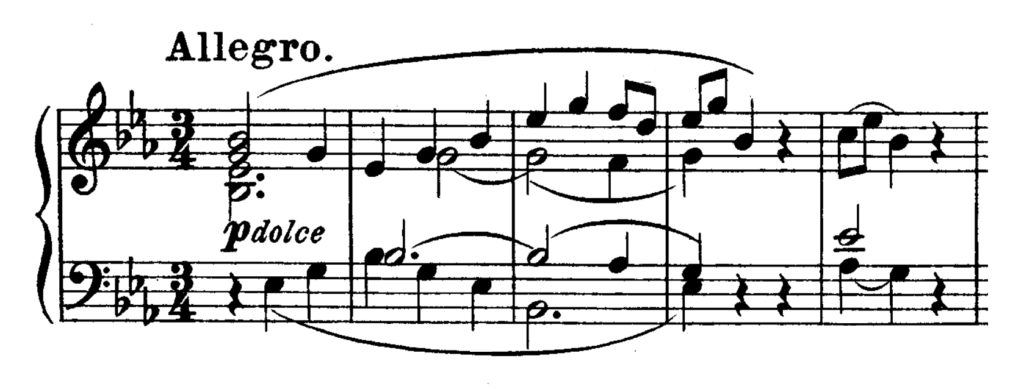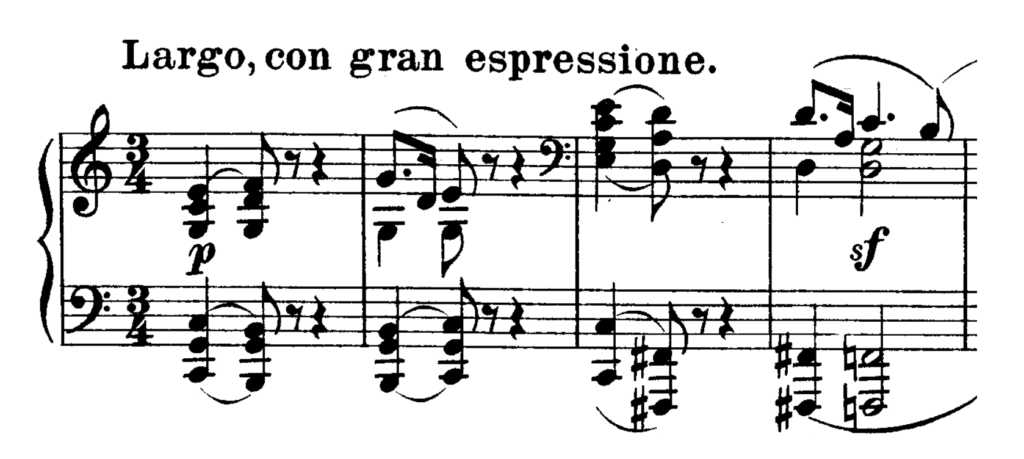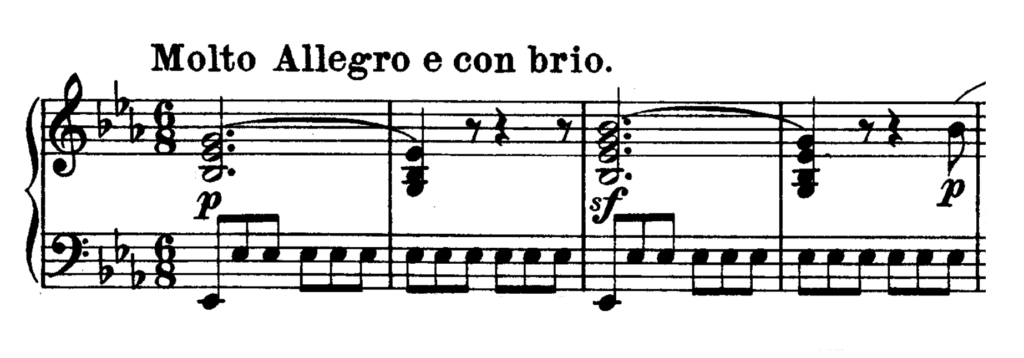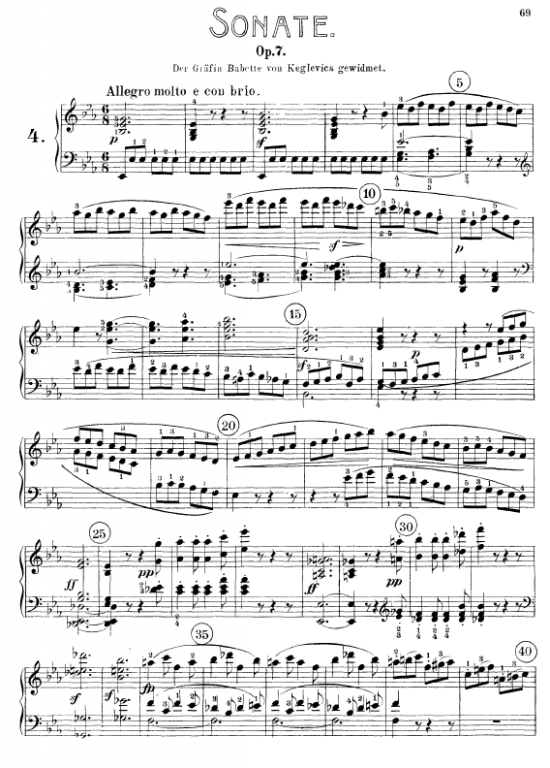Слушать сонату №4
Итак, Вы уже знаете, что данное произведение молодого Бетховена получило второе название — «Большая соната». И несложно догадаться, почему.
Дело в том, что из тридцати двух сонат Бетховена, относительно неизвестная Четвертая фортепианная соната является второй по продолжительности, проигрывая в этом плане лишь Сонате №29, более известной, как «Хаммерклавир». Но последнюю композитор напишет аж спустя более, чем 20 лет.
Отличилось произведение не только своей необычной продолжительностью, но также и новизной характера. Если, обсуждая первые три сонаты, посвященные Гайдну, мы еще говорили о возможном компромиссе со стороны Бетховена, дабы не испугать излишним новаторством венскую публику, привыкшую к «легким» и изящным произведениям Моцарта и того же Гайдна, то четвертая соната — это просто революционный рывок вперед, не оставляющий никаких поводов сомневаться о стремлении молодого Бетховена к творческой индивидуальности.
При этом, складывается впечатление, что в данной сонате Людвиг будто бы пытался найти какие-то совершенно новые творческие пути, необходимые для выражения своих истинных художественных замыслов, значительно отличавшихся от стандартных шаблонов, созданных старшими композиторами.
Примечательно то, что в отличие от поздних произведений композитора, в Четвертой сонате знаменитая бетховеновская энергетика выражена не нервозностью и агрессией, а наоборот, радостью, торжеством, фанфарами. Ведь период работы над Большой сонатой совпал с достаточно светлыми временами, которых в жизни композитора было не так много.
Послушать Четвертую сонату можно на видео ниже. Подобно предыдущим сонатам из Второго опуса, данная соната тоже является четырехчастной:
- Часть 1. «Allegro molto e con brio» (на видео начинается с 0:19)
- Часть 2. «Largo, con grand espressione» (начало на видео с 8:24 )
- Часть 3. «Allegro» (на видео с 16:07)
- Часть 4. «Rondo, poco allegretto e grazioso» (с 23:35)
Third Movement (Allegro)
Form: Scherzo and Trio. Eb major.


EXPOSITION:
Bars 1-8: First subject in E flat major (tonic). The first subject ends with half-close on the dominant.
Bars 9-14: Connecting Episode. The connecting episode consists of Bars 1-4 altered at the end, by the insertion of a cadence in C minor, which is repeated in B flat major (dominant).
Bars 15-24: Second Subject in B flat major. The second subject commences with a figure taken from Bars 3-4, which is repeated four times.
Double bar and repeat.
RECAPITULATION:
Bars 43-50: First Subject in original key.
Bars 51-71: Connecting episode. The connecting episode re-appears extended; it commences with the same material as before, transposed into E flat minor, followed by a passage in C flat major; it ends of the chord of the augmented 6th (keys of E flat major), followed by two bars on the dominant.
Bars 71-86: Second Subject (varied) in E flat major (tonic). The second subject re-appears varied and extended and transposed into tonic key.
Bar 87: Coda. The Coda is constructed on pedal point in the bass.
Double bar and repeat from Bar 25.
TRIO:
Bars 1-17: First subject in E flat minor (tonic), ending in B flat major. This movement is in triplets throughout.
Double bar and repeat.
Bars 18-31: Development. The development begins in B flat minor and ends in E flat minor.
Bars 31-45: First Subject in original key. The first subject re-appears altered so as to end in the tonic key.
Bars 45-End of Trio Coda. The Coda is built upon tonic pedal point in the bass.
“Allegro”
Navigation etc.
| Beethoven Piano Sonatas | |
|
|
Кому посвящена Четвертая соната?
Несмотря на то, что буквально абзацем выше мы уже ответили на сей вопрос, все же в литературе нередко встречается путаница по поводу того, кому именно посвящено данное произведение. Нет, на самом деле все музыканты прекрасно знают, что данная соната посвящена некой девушке по прозвищу «Бабетта».
Однако на некоторых форумах и биографических источниках авторы путают эту девушку с другой Бабеттой, а именно с Анной Барбарой Кох — дочерью хозяйки гостиницы «Цергартен» на рыночной площади Бонна, где любил отдыхать молодой Бетховен в компании самых близких друзей. Кстати, сама Бабетта также была «своим человеком» в той компании (подробнее об этом эпизоде биографии).
Кстати, если верить слухам, то в отличие от той самой «боннской» Бабетты, которую Вегелер (близкий друг Бетховена) открыто называл «Самой красивой женщиной на его памяти», графиня Кеглевич, о которой мы говорим сегодня, далеко не блистала красотой.
В принципе, возможно, так оно и было. Ведь, как мы знаем точно, Бетховен очень легко и быстро влюблялся в своих красивых и талантливых учениц (графиня Кеглевич, как раз, была его ученицей). А, учитывая, что Людвиг особо не испытывал любовных чувств конкретно к этой персоне, можно предположить, что она, действительно, обладала далеко не самой красивой внешностью. Иначе влюбчивый Бетховен вряд ли обошел бы ее стороной.
Но, судя по всему, сам композитор не испытывал к своей ученице Бабетте ничего, кроме дружеских чувств (хотя, есть и другие мнения). Однако мы не без оснований можем полагать, что Бетховен еще, как минимум, восхищался ее талантом, как пианистки.
Действительно, многие биографические источники свидетельствуют о том, что девушка была достаточно сильной пианисткой. В принципе, это частично подтверждается технической сложностью произведений, которые Бетховен посвятил Бабетте, включая как эту сонату, так и несколько других произведений:
- Вариации на тему Сальери (WoO 73);
- Шесть вариаций в Фа мажоре (Опус 34);
- Концерт для ф-но До мажор (Опус 15).
Ведь все вышеперечисленные произведения достаточно сложны с точки зрения техники, а значит, задают высокие требования к исполняющему их пианисту. А раз Бетховен посвятил их Бабетте, то, судя по всему, он считал ее достаточно сильной пианисткой.
Second Movement (Largo con Gran Espressione)
Form: Ternary Form. C major.

The form of this movement somewhat resembles Sonata Form. The key of C is an unusual one for a second movement where the first movement is in the key of E flat.
FIRST PART:
Bars 1-24: First subject in C major (tonic). The first subject consists of an eight-bar sentence ending in C major, followed by a four-bar sentence in G major, after which there is a varied and extended repetition of Bars 1-8.
Bar 24: The transition from the first subject to the second subject is affected by the passage in Bar 24.

Bars 25-28: Second Subject beginning in A flat major. The second subject, instead of being in G major, appears in A flat major; it only consists of a phrase of four bars.
SECOND PART:
Bars 29-51: The development commences with a four-bar phrase in F minor based on the second subject, Bars 29-32. At Bar 33 a great portion of the second subject appears in D flat major. Bars 37-50 constitute a passage, leading back to the tonic key, which contains some development of the first subject.
THIRD PART:
Bars 51-74: First Subject (varied) in original key.
Bars 74-84: Second Subject (varier) in C major (tonic). The second subject re-appears transposed into the tonic key, varied and extended.
Bars 84-End: Coda. The Coda chiefly refers to previous material; the last four bars consist of a varied repetition of bars 1-4 differently harmonized.
General Information
| Work Title | Piano Sonata No.4 |
|---|---|
| Alternative. Title | Grand Sonata |
| Name Translations | Piano Sonata No. 4; Klaviersonate Nr. 4; سونات ۴ پیانو; Pianosonaatti nro 4; Sonate pour piano nº 4 de Beethoven; Sonata per pianoforte n. 4; ピアノソナタ第4番; Pianosonate nr. 4; IV Sonata fortepianowa Beethovena; Sonata para piano n.º 4; Соната для фортепиано № 4; Соната для фортепіано № 4; Sonata per a piano núm. 4; 피아노 소나타 4번; Πιάνο Σονάτα No 4. (Μπετόβεν); 第4號奏鳴曲 |
| Name Aliases | Piano Sonata No. 4 in E-flat Major, Op. 7; Grande sonata; Pianosonate nr. 4 (Beethoven) |
| Authorities | |
| Composer | Beethoven, Ludwig van |
| Opus/Catalogue NumberOp./Cat. No. | Op.7 |
| I-Catalogue NumberI-Cat. No. | ILB 165 |
| Key | E-flat major |
| Movements/SectionsMov’ts/Sec’s | 4 movements:
|
| Year/Date of CompositionY/D of Comp. | 1796–97 |
| First Publication. | 1797 |
| Dedication | Gräfin Babette von Keglevics |
| Average DurationAvg. Duration | 28 minutes |
| Composer Time PeriodComp. Period | Classical |
| Piece Style | Classical |
| Instrumentation | piano |
| External Links | Wikipedia article |
Fourth Movement (Poco Allegretto E Grazioso)
Form: Rondo Form. Eb major.


FIRST PART:
Bars 1-17: First subject in E flat major (tonic). The first subject consists of a sentence of eight bars, ending with full close on tonic repeated varied, Bars 9-17.
Bars 17-37: Episode. The episode begins with a phrase borrowed from the first subject (Bars 9-10). It modulates to the dominant, in which key a new figure is introduced in the bass (Bars 25-26), the latter part of which is repeated twelve times in the succeeding eight bars. It ends with full close in B flat major.
Bars 37-49: Second Subject in B flat major. The second subject consists of a sentence of eight bars (Bars 37-45), beginning in C minor and ending in B flat major. Bars 45-48 are varied repetition of Bars 43-44.
Bars 49-51: Connecting passage modulating to tonic key. After the second subject there follows a passage leading to tonic key, Bars 45-51.
Bars 51-63: First subject in original key. The first subject re-appears curtailed. After arriving at the note B flat, Bar 63, which corresponds to the pause note in the original (Bar 13), it is curt short by the note B natural, Bar 64, leading to the key of C minor.
SECOND PART:
Bars 65-91: Third subject in C minor. The third subject is divided into two parts, both founded upon the same figures, and both repeated. It ends, Bar 91, after which there is a passage leading into the third appearance of the first subject.
Bars 91-97: Connecting passage.
THIRD PART:
Bars 97-113: First subject (varied) in original key.
Bars 113-133: Episode. The episode re-appears slightly altered and transposed so as to end in the tonic key.
Bars 133-145: Second Subject in E flat major (tonic). The second subject re-appears transposed into tonic key.
Bars 146-170: First Subject in original key. The first subject re-appears varied. After arriving at the pause referred to earlier (Bar 13), it proceeds in the key of E major for a few bars, ending ultimately in tonic key
Bars 170-End: Coda. The Coda is constructed on similar figures to the third subject.
First Movement (Allegro Molto E Con Brio )
Form: Sonata Form. Eb major.


EXPOSITION:
Bars 1-17: First Subject in E flat major (tonic). The first subject is constructed on two distinct figures, Bars 1-2 and 5-6. It ends with a full close on the tonic, Bar 17.
Bars 17-41: Connecting episode. The connecting episode commences with a four-bar passage, Bars 17-20, which appears inverted, Bars 21-24. It ends on pedal point.
Bars 41-127: Second Subject in B flat major. The second subject may be divided into four parts, all in the key of the dominant: first par, Bars 41-59; second part, Bars 59-93; third part, Bars 93-111; fourth part, Bars 111-127. The last is entirely constructed on dominant pedal point.
Bars 127-136: Coda. The Coda consists of two bars (127-128) repeated (varied) three times in succession, simply confirming the perfect cadence.
Double bar and repeat.
DEVELOPMENT:
Bars 137-188: The development contains references to the first subject, the connecting episode figure, bars 141-163, and also to some material found in the Coda.
RECAPITULATION:
Bars 189-201: First Subject in original key. The first subject re-appears shortened, the concluding four bars being omitted.
Bars 201-220: Connecting Episode. The connecting re-appears considerably altered; it branches off from what was before the concluding phrase of the first subject; at Bar 205 it reverts to the original, the last six bars of which (with slight inversion of parts) appear transposed into B flat major.
Bars 221-307: Second Subject in E flat major (tonic).
Bars 307-End: Coda. The Coda only resembles the original in the first six measures; it then refers to both the first and second subjects, and to the first Coda.
































